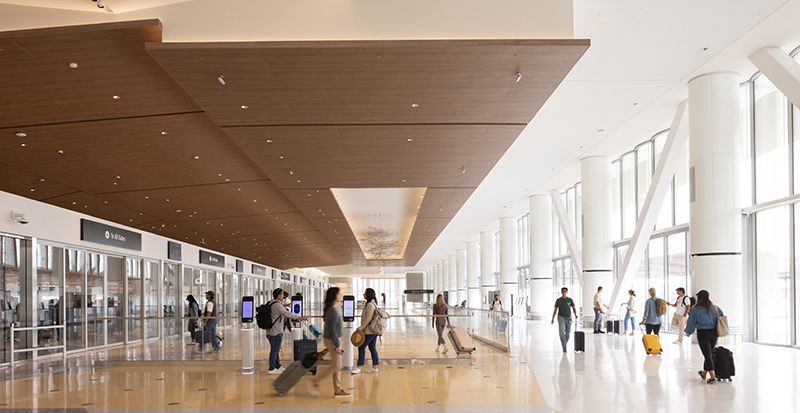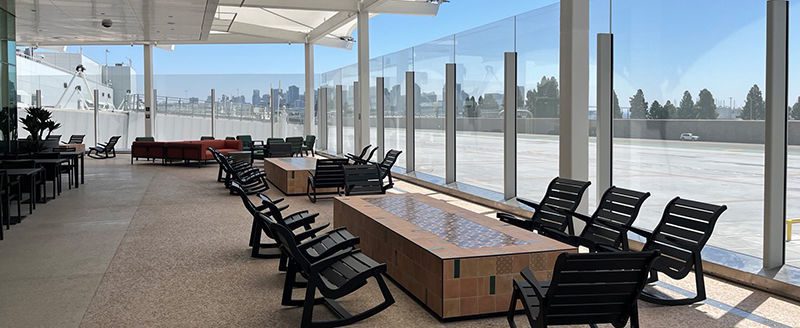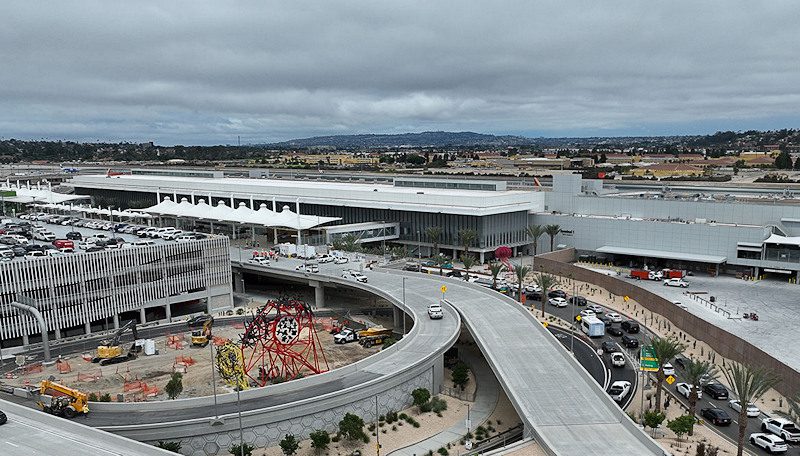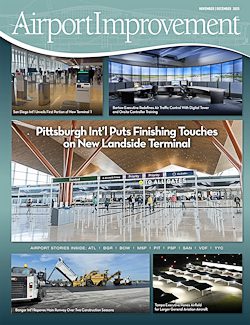This September, San Diego International Airport (SAN) marked a major step in reimagining the entire airport when it opened the first phase of a $3.8 billion expansion and modernization in Terminal 1. “The existing Terminal 1 has served our community for more than five decades and today we are ushering in a new era,” said Kimberly Becker, president and chief executive officer of the San Diego County Regional Airport Authority. “The New T1 provides the comfort, convenience and efficiency travelers expect while reflecting the spirit of San Diego.”
 More specifically, the 940,000 square feet of updated space features 19 gates, innovative seismic design, upgraded security lanes, more natural lighting, artwork that provides wayfinding cues, new concessions and an outdoor patio. Other major additions include outdoor check-in stations, new airport roadways and a five-story parking plaza.
More specifically, the 940,000 square feet of updated space features 19 gates, innovative seismic design, upgraded security lanes, more natural lighting, artwork that provides wayfinding cues, new concessions and an outdoor patio. Other major additions include outdoor check-in stations, new airport roadways and a five-story parking plaza.
At nearly 60 years old, the previous Terminal 1 facilities struggled to handle increasingly large waves of passengers flooding through its gates each year. San Diego County Regional Airport Authority, which owns and operates SAN, was well aware of the frustration guests were feeling. Vice President and Chief Development Officer Angela Shafer-Payne recalls reading complaints in passenger surveys and seeing the general look of distaste on travelers’ faces. The airlines were also voicing dissatisfaction about the building. “Everything was so undefined with that facility,” she says. “We knew we needed to replace it.”
| facts&figures
Project: Terminal Expansion & Modernization Location: San Diego Int’l Airport Owner & Operator: San Diego County Regional Airport Authority Terminal: 1 Cost: $3.8 billion Funding: About $3.2 billion in debt; $300 million from Bipartisan Infrastructure Law – Airport Terminal Program; $300 million in airport cash Completed Projects: Phase 1A (Nov. 2021-Sept. 2025) – Built first 940,000 sq. ft of terminal, first 19 gates, elevated departures roadway, outdoor check-in pavilions, airport arrivals roadway, five-story parking plaza Projects in Process: Phase 1B (Sept. 2025- early 2028) – Demo of old Terminal 1, remaining 265,000 sq. ft. construction of new Terminal 1, airside improvements, 11 more gates Forecasting Consultant: LeighFisher Design-Build Team: Joint venture of Turner & FlatironDragados, with Gensler as lead architect Structural Engineering: Magnusson Klemencic Associates (MKA) Civil & Geotechnical Engineer (Airside & Landside): Kleinfelder Civil Engineer (Roadways & Utilities): Latitude 33 Construction Manager at Risk: AECOM Commissioning: CriticalArc Glass Façade Design: James Carpenter Design Associates; Gensler; Walter P. Moore; Starq; Enclos; Turner Engineering Group Glass Façade Supplier & Installer: Enclos Corp. Structural Steel/Buckling-Restrained Braces Subcontractor: Seismic Bracing Co. Fabricator & Erector for Buckling-Restrained Braces: W&W l AFCO Steel Baggage Handling System: Vanderlande Battery Energy Storage System: Critical Loop, Inc. Digital Signage, Kiosks, Security Technologies: SITA Airport Directories: Art of Context Seating: Zoeftig Temporary Wall Units: SwiftWall Key Benefits: Correcting undersized nature of previous terminal; enhancing passenger experience |
The project rose to the top of the Airport Authority’s list following the expansion of Terminal 2 in 2013; and consultant LeighFisher was already hired to complete an aviation forecast. “We were coming out of the recession at that time so we wanted to know what the growth of this airport was going to look like. We just had to figure out the mechanics of how we could make that happen,” says Shafer-Payne.
Moving the Decimal Points
The original version of Terminal 1 opened in 1967 and was built for 500,000 annual passengers but served 2.5 million its very first year. Today, SAN is the busiest single-runway commercial airport in the U.S. and served 25 million passengers last year alone, with approximately 10 million passing through Terminal 1.
Naturally, construction prices have also changed over the decades. The facility that cost $7 million to build in 1967 would cost about $67 million in today’s dollars. And the new Terminal 1 will be three times larger than its predecessor, with updated structural fortification, technology and sustainability features, plus additional access roadways, parking facilities and ancillary buildings. Funding for the behemoth $3.8 billion build is coming from three main sources: airport revenues, including airline lease and operating agreements; airport revenue bond financing from the Airport Authority; and federal support via the Bipartisan Infrastructure Law – Airport Terminal Program and other FAA grants. Notably, the state of California is not providing funds.
Land Constraints and Design Challenges
With funding for the project seemingly sorted, geography obstacles glared like sunshine off of San Diego Bay. The airport has a notably small footprint—only 661 acres—and sits just 17 feet above sea level on a peninsula near the Pacific Ocean. In fact, it’s built on reclaimed land formed by filled tidelands of San Diego Bay. Space to expand is extremely limited, with downtown San Diego only three miles away and U.S. Naval Base Coronado also nearby.
Even though SAN has only one runway, the project team knew it could not add another. Instead, planners had to find creative ways to optimize the existing real estate when designing and building a much larger version of Terminal 1.
To help manage the mammoth initiative’s many moving parts, the Airport Authority developed a programmatic document with its stakeholders for project discussions. Shafer-Payne shares that the Authority spent more than a year researching what TSA, tenant airlines and key internal stakeholders wanted in the new facilities.
One of the top requests/suggestions was to showcase the airport’s expansive coastal and city views—a job assigned to Gensler, the global architecture and design firm that served in a similar capacity for the Terminal 2 expansion. To set clear expectations, the Airport Authority specified that Terminal 1 should be in the same expression as Terminal 2 but not a mirror image.
Gensler Principal and Design Director Terence Young embraced the mission. “We have the opportunity to really change how a community both sees itself in its buildings and how it takes care of everybody,” says Young. “They [the Airport Authority] were super-focused on the passenger experience.
“It’s really putting this through the lens of the customers that come to San Diego as well as all the employees that spend the time working there day in, day out,” he adds. “We just wanted to make it pleasant and high-performance for each kind of person individually.”
One major challenge arose when geotechnical engineers surveying the construction site found it was located near the active Rose Canyon Fault Zone. This required additional time and expense to bolster all of the structures to comply with seismic requirements.
Another Major Twist
The progressive design-build project was awarded to the joint venture of Turner Construction Company and FlatironDragados in June 2020, and Gensler was selected to lead the design effort. With COVID-19 in full force, there were nationwide restrictions on in-person meetings, and access to building supplies and materials was limited. At the end of the design validation phase, the budget exceeded the Airport Authority’s original expectation, partially due to significant price escalations for materials and supply chain problems caused by pandemic-driven shutdowns.
“During Covid we were designing to a moving budget target,” Young recalls. “For instance, plywood at Home Depot had doubled in price; the price of structural steel more than doubled.”
Reducing the height of the 1.1 million-square-foot building by 10 to15 feet substantially decreased the amount of steel needed without compromising the spacious feel, he explains. Gensler created a digital model of the design and used virtual reality technology to display it. “We were able to put the executive decision makers inside the model,” says Young. “They could literally walk through every iteration of our design like a video game.”
For efficient communication, Turner Vice President and Terminal Manager Paul Costa appointed captains in all of the major disciplines. It was their responsibility to manage and disseminate information to the associated trades and engineers working on the project.
 The design validation period that was originally expected to take nine months stretched to 15 months, even though the teams masked up and reported every day to collaborate through the process. “The Airport Authority should be commended for taking a leap of faith when many other airports were hitting pause on projects,” says Turner Vice President and Design Director Lori Ann Stevens. “They took a risk and said, ‘Let’s keep going.’”
The design validation period that was originally expected to take nine months stretched to 15 months, even though the teams masked up and reported every day to collaborate through the process. “The Airport Authority should be commended for taking a leap of faith when many other airports were hitting pause on projects,” says Turner Vice President and Design Director Lori Ann Stevens. “They took a risk and said, ‘Let’s keep going.’”
Scott Brickner, vice president and chief financial officer with the Airport Authority, recalls that the decision to move forward with the project felt risky. Traffic at SAN had dropped to 3% of pre-pandemic numbers and all non-airline revenue was gone. Even though the airport received approximately $200 million of federal relief funding, the decision to move forward was largely seen as gutsy.
 However, proceeding with the project while passenger activity was low allowed construction crews to mobilize more easily and work more efficiently. It was also a great time to bid the work and borrow almost $2 billion because interest rates were extremely low, Brickner adds. “Our debt issuance back in 2021 saved over $400 million compared to our original plan of finance due to the favorable interest rates we secured,” he elaborates.
However, proceeding with the project while passenger activity was low allowed construction crews to mobilize more easily and work more efficiently. It was also a great time to bid the work and borrow almost $2 billion because interest rates were extremely low, Brickner adds. “Our debt issuance back in 2021 saved over $400 million compared to our original plan of finance due to the favorable interest rates we secured,” he elaborates.
Keeping It Glassy
The design for Terminal 1 capitalizes on the area’s weather (sunlight nearly 365 days a year) and the airport’s stunning views of water and city. The challenge, which has been a trial-and-error experiment over time in Terminal 2, was to manipulate windows, glass treatments and shades to reduce the glare and heat from sunlight on people and infrastructure inside the terminal.
At certain times of the year, ticket agents struggle with glare on their computer screens, the common-use self-service kiosks are difficult for customers to read, and maintaining the window shades is cumbersome for airport staff. Wanting better conditions in the new terminal, the Airport Authority asked Gensler to bring in world-renowned glass architect James Carpenter.
 Young, from Gensler, says it was an honor and a privilege to work with Carpenter and his associates on the ticketing hall façade design. Inspired by the San Diego Bay and Pacific Ocean directly across from the airport, Carpenter designed curved, fritted and unitized glass panels that provide the shade, energy savings and sense of place the Airport Authority desired. As an added bonus, the 800-foot-long, 33-foot-high feature is also a piece of public art known as Luminous Wave.
Young, from Gensler, says it was an honor and a privilege to work with Carpenter and his associates on the ticketing hall façade design. Inspired by the San Diego Bay and Pacific Ocean directly across from the airport, Carpenter designed curved, fritted and unitized glass panels that provide the shade, energy savings and sense of place the Airport Authority desired. As an added bonus, the 800-foot-long, 33-foot-high feature is also a piece of public art known as Luminous Wave.
Originally designed to be modular, it ended up being 537 individual pieces of curved glass from Enclos Corp. The manufacturing and installation process was a global effort, with full-height components traveling from China to Thailand to San Diego and arriving intact. Each piece of glass had its own unique frit identity and needed to be placed in an exact order on the floor to ensure the right curves during installation. Crews used custom equipment with suction cups to lift each panel into place, with engineering on the fly to make everything fit together as envisioned by Carpenter.
“Thanks to extensive planning, installation of the wall system went more smoothly than I think a lot of people thought it was going to go,” says Turner Vice President and Project Director Steve Rule. “The team did a fantastic job.”

Custom glass panels and diagonal support braces are two signature design elements of the new terminal.
Foundational Thinking
The structure for the new 1.1 million-square-foot terminal uses buckling-restrained braces to help comply with seismic requirements for buildings near an active fault. The steel components are specially engineered to absorb and disperse earthquake forces.
 Because Terminal 1 is a progressive design-build project, construction could begin before the design was 100% complete. It also provided time for designers to add the buckling-restrained braces, which allowed lateral and gravity loads to be placed on the outside of the building. Stevens explains that this eliminated many of the large, cumbersome support columns throughout the terminal and created a much more seamless flow.
Because Terminal 1 is a progressive design-build project, construction could begin before the design was 100% complete. It also provided time for designers to add the buckling-restrained braces, which allowed lateral and gravity loads to be placed on the outside of the building. Stevens explains that this eliminated many of the large, cumbersome support columns throughout the terminal and created a much more seamless flow.
Young explains that buckling-restrained braces are not typically used in airport terminals because the diagonal structural members are immovable and restrict future design flexibility. “So we intentionally placed these braces in locations which will not restrict likely future expansions,” he comments. The braces reduced the number of interior columns and, in turn, helped decrease the total volume of steel needed for the project. Shafer-Payne estimates the associated cost savings at nearly $60 million.
Sustainable Design
As the first major U.S. airport to create a formal sustainability policy for new construction and renovations, SAN is considered an industry leader in environmentally responsible infrastructure. The airport achieved LEED Platinum certification for its Terminal 2 Green Build expansion in 2013 and is pursuing LEED v4 Silver certification for the Terminal 1 project.
The lengthy list of green design elements includes a stormwater reuse system with a 3-million-gallon cistern on the north side of the airfield and a 1-million-gallon cistern on the south side. The airport also captures condensation from the air handling units on jet bridges and planted drought-tolerant landscaping in front of the new building.
Years of designing large-scale buildings has taught Young that lights are usually the biggest component of an airport’s utility bill. With this project, the objective was to dramatically reduce electricity consumption by leveraging San Diego’s abundant natural light. “One of the things we did was harvest daylight,” says Young, noting the goal to eventually use only electric lights after dark.

The new terrace is primarily intended for patrons of nearby food and beverage concessions.
During the next project phase, a photovoltaic system will be installed on the roof of Terminal 1 to supply a total of 9.5 megawatts of electricity, A battery energy storage system will store power coming from the photovoltaic system. Shafer-Payne notes that this stored energy will help shave off peak energy demand in the early mornings when terminal lights and TSA equipment are activated.
Terminal Features
The recently completed Phase 1A of the Terminal 1 project constructed 940,000 square feet of what will ultimately be a
1.1-million-square-foot facility when Phase 1B is finished in 2028. Already, the new terminal is nearly three times the size of its predecessor.
Key features of Phase 1A include:
- 19 new gates,
- outdoor check-in stations,
- 69 self-service check-in kiosks,
- 66 ticket counters,
- 13 TSA checkpoint lanes,
- seven baggage carrousels,
- an outdoor patio area that can accommodate more than 300 people,
- 21 elevators and 10 energy-saving escalators,
- 90,000 square feet of concessions space with 12 food/beverage outlets and five retail stores,
- 29 restrooms (nearly twice as many as before) and
- five pet relief areas, including one inside the terminal.
Commissioned artwork throughout the new terminal doubles as wayfinding aids. Rotating art exhibits and live performances by musicians and other performing artists are scheduled throughout the year to further enhance the passenger experience.
“If you can elevate your airport and have partnerships with artists so that you’re really telling a story about the culture of cities, I think that is a real opportunity for new airports today and for all of us going forward,” says Gensler’s Young.
Open for Business
 Rule, from Turner, is elated about what the project team accomplished given the unique challenges it encountered over the past five years. “When you look at the size of the facility, it was just an amazing feat of communication, transparency, trust—all those things that came together to develop what we did here,” he remarks.
Rule, from Turner, is elated about what the project team accomplished given the unique challenges it encountered over the past five years. “When you look at the size of the facility, it was just an amazing feat of communication, transparency, trust—all those things that came together to develop what we did here,” he remarks.
The Airport Authority’s Brickner focuses on the positive financial impact throughout the region of jobs created during construction and ongoing employment from new concessions. He also highlights the benefits of more terminal space for airlines operating at SAN. “But ultimately, it is the tremendous improvement in the customer experience for all of our passengers and our community,” he emphasizes.
Phase 1B, which will add another 265,000 square feet to Terminal 1, is expected to be finished in 2028. It will include 11 more gates, 13 concessions, two club lounges, and possibly two more baggage carousels.



